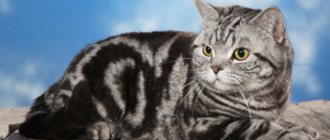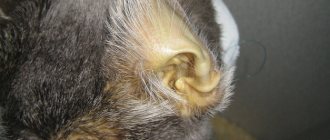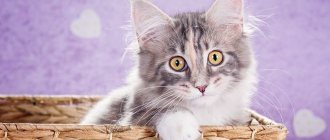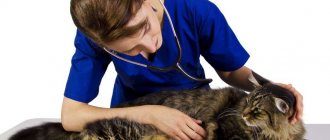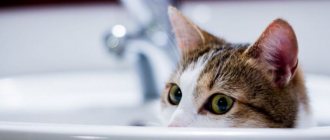Varieties of tortoiseshell color
There are several varieties of pets in the world that are distinguished by their tortoiseshell color. Breeders conditionally divided such cats into two main groups:
- Tortie. Animals that fall into this category are often called scaly. It is very difficult to imagine such a shade of fur on a cat from a verbal description. You can recognize torti representatives by their unusual mixture of bright colors. The cat's fur is more reminiscent of fish scales due to such a variety of shades. There are no clear boundaries between colors. Multi-colored specks are arranged in a chaotic manner. Due to this feature, it is almost impossible to meet two torties that have the same color.
- Calico. This color is usually called patchwork. It is dominated by various colored specks that look like large spots. This is the main difference between the representatives of the group and the torti. The spots have clear boundaries, making them easily distinguishable on the cat's fur.
Breeders classify tortoiseshell cats with white patches into a separate group. This combination looks very beautiful and unusual. Quite often, tricolored animals that fall into this category will have white underparts while the back and legs are brightly colored.
A tortoiseshell cat can be patterned or solid in color. In the first case, each multi-colored spot on the animal’s body has a unique pattern. If the color is solid, then the inclusions do not have such features. In this case, the stains appear as a whole cloth.
The shades in which the fur of a tortoiseshell cat is dyed can be very different. The color variations are very diverse. The black tint in some pets turns into brown or chocolate. And red can fade into red or orange.
Breeds
Tricolor coats are common to many breeds. And even ordinary yard cats can often boast of an unusual fur coat. Among domestic breeds, turtles can most often be found among:
- Siberian cats;
- Japanese bobtails;
- sphinxes (Canadian and Don);
- Maine Coons;
- British;
- Scottish fold cats;
- Persian cats;
- rex (Ural, Selkirk, Devon, Cornish);
- American Shorthair;
- and among many others.
Thanks to genes, a tricolor color can appear in almost any cat, regardless of its breed. But the standards of some breeds are so strict that sometimes this color is not acceptable. In addition, various variations with tortoiseshell color are often limited.
For example, a British cat can have eyes of any color, but the undercoat must match the main color. The Kurilian Bobtail should not have diluted shades of black in its coat, and the Neva Masquerade cat must have blue irises.
Characteristics of cats
The tortoiseshell pet is a very flirtatious animal. His character is quite flexible, due to which the owner of the cat does not face any serious difficulties in the process of raising it. This pet loves affection and active games. He can even be trained. If the cat owner is not lazy and trains his pet, he will quickly learn to go to the litter box, not damage upholstered furniture, and eat any treats that are offered to him.
Many owners of tortoiseshell cats claim that such animals should be treated very gently and affectionately. This is because they have an overly vulnerable soul. This means that it is not so difficult to offend a tortoiseshell pet. So you shouldn’t scold your cat again without a good reason, so as not to spoil your trusting relationship with it. If an animal is mischievous, you just need to talk to it seriously. The cat will definitely understand everything without physical punishment.
Cats who are the proud owners of a tortoiseshell color form a strong bond with their owner. They can wait a long time for him to return home. In addition, these pets perfectly sense a person’s mood. A tortoiseshell pet is unlikely to tire its owner with its presence if the owner is very busy. A cat will definitely try to cheer up a person if he is upset. You should not drive away a purring pet that is tirelessly caressed. This is how the animal tries to calm the owner down and show pity. Based on this, we can confidently say that a tortoiseshell pet is a true friend for a person who is able to support him in difficult times.
A tortoiseshell cat will have no problem playing active games all day long. If the owner gets tired and stops showing interest in her, then she herself will find another activity for which she does not need company.
Rules for caring for a tortoiseshell cat
Turtle pets do not require specific care. This is one of the main advantages of such cats. They are subject to generally accepted pet care requirements. They include the following rules and recommendations:
- It is necessary to communicate with your pet regularly so that it does not get bored or feel lonely.
- You should provide your cat with a balanced diet. It is recommended to give her seasonal plant food so that the animal’s body does not lack beneficial microelements.
- It is worth visiting the veterinarian's office with your pet periodically.
- It is necessary to carry out hygiene procedures for the cat, which include regular bathing, trimming claws and cleaning the ears.
- The animal should be provided with comfortable living conditions. He should not experience anxiety and fear while at home.
- The cat should be allowed out regularly for walks in the fresh air.
For tortoiseshell cats, there are other care rules that are provided for by their breed. The regularity of certain procedures for an animal depends on the state of health, the length of the coat and other factors that influence it.
Tabby cat breeds
American Curl
According to the Encyclopedia Britannica, the dark markings of purebred cats should have the following configuration: stripes and curls on the face, a pattern similar to butterfly wings on the shoulders, two necklaces on the neck, stripes on the back and sides, rings on the legs and tail . Famous breeds - from the solid Norwegian Forest to the funny Curls - boast a full range of patterns.
The British cat can have all varieties of tabby: classic, mackerel, spotted and ticked appear in all sorts of color combinations. Along with the traditional blue, there is a ticked silver or gold Briton.
In 1990, the Asian tabby was recognized as a separate breed. This breed is also characterized by all types of this color; the presence of dark “eyeliner” around the eyes is especially noted. In this case, the main color can be any.
The Egyptian Mau can be silver, bronze, smoky, but invariably with a spotted pattern on the coat. Only stains, no streaks or stains! Occasionally, marbled Mau are born, but they are disqualified and not allowed to participate in exhibitions and matings. Interestingly, the spots cover not only the fur, but also the skin of these cats.
Pixie bob
The Pixie Bob is another breed that has a spotted pattern as a mandatory attribute. These cats look like a mini lynx and have tufted ears and a short tail.
The Abyssinian cat, one of the oldest breeds, is a perfect example of a ticked agouti with 2 or 3 shades along the length of the hair. As a result of selection, this breed did not have a single residual trait, however, any Abyssinian is a tabby. If you look closely, you can find the treasured letter above the bridge of the nose and a darker shade on the paws.
Bengal cat
The Bengal breed demonstrates an incredibly beautiful embodiment of the spotted and marbled tabby. This short-haired hybrid of a domestic and wild leopard cat is distinguished by its bright contrast and clarity of pattern; the fur of some Bengals has a unique shine (glitter).
Perhaps the most striped of all tabby owners is the toyger. The domestic tiger boasts unusually clear black stripes on an orange background. It is noteworthy that toyger kittens from birth have this color with a clear pattern, while in kittens of other breeds it may appear later or, on the contrary, fade over time.
Interesting beliefs about tortoiseshell cats
People have long been attracted to the tortoiseshell color of cats. Perhaps this is the reason why a large number of different beliefs and traditions are associated with such animals. Many nations have their own legends that relate to these pets.
Residents of Ancient Rus' were sure that a tricolor cat could protect their house from fire. And at that time it was the biggest problem. In America, people adopted a tortoiseshell cat to bring financial stability into their home. Representatives of the people of Japan were also convinced that this animal is a symbol of happiness and success in financial matters.
The British believe that a tortoise pet can protect the house from evil forces. It also has a positive effect on marital relationships.
Even sailors have their own superstition regarding the tricolor cat. They believe that such an animal helps them survive even the most terrible storm. Therefore, it should not be surprising that many sailors would like to take such a cat with them on a voyage.

